Literary & Historical Manuscripts
The Morgan's collection of literary and historical manuscripts includes complete manuscripts and working drafts of poetry and prose as well as correspondence, journals, and other documents of important British, European, and American authors, artists, scientists, and historical and political figures from the fifteenth through the twentieth centuries. The handwritten documents in the collection preserve the process of human thought and creativity—from mind to pen to paper—with an immediacy and power lacking in texts produced electronically.
The general pattern of the collection was established by Pierpont Morgan, who began to acquire literary and historical manuscripts on a large scale during the 1890s. He sought not to achieve comprehensiveness in any particular field but rather to assemble important documents related to events of historical significance, lives of notable individuals, and the creation of great literary works. By his death in 1913, he had gathered a number of exceptional documents handwritten or signed by influential figures in Western culture, including Elizabeth I, the signers of the Declaration of Independence, Napoléon, Sir Isaac Newton, and Voltaire. Morgan had a great interest in major British writers; a centerpiece of his collection was—and still is—the sole surviving manuscript of John Milton's Paradise Lost, transcribed and corrected under the direction of the blind poet. Other collection highlights are Charles Dickens's manuscript of A Christmas Carol, Henry David Thoreau's journals, Thomas Jefferson's letters to his daughter Martha, and manuscripts and letters of Jane Austen, Charlotte Brontë, Lord Byron, Wilkie Collins, Albert Einstein, John Keats, Abraham Lincoln, and John Steinbeck.
The Morgan's collection of literary and historical manuscripts has been enriched by many gifts and acquisitions, and twentieth-century holdings have increased significantly. The collection, particularly strong in artists' letters, was greatly enhanced by the Pierre Matisse Gallery Archives, the gift of the Pierre Matisse Foundation in 1997. These archives include more than fifteen hundred letters as well as records of the gallery installations of Balthus, Chagall, Dubuffet, Giacometti, Miró, and other twentieth-century artists. The Carter Burden Collection of American Literature includes important manuscripts and correspondence of John Cheever, Ezra Pound, and Tennessee Williams. The 1999 acquisition of The Paris Review Archive added correspondence, interviews, typescripts, and revised proofs of several hundred post-World War II writers, including Donald Hall, Ernest Hemingway, Jack Kerouac, Norman Mailer, Toni Morrison, George Plimpton, Philip Roth, and Anne Sexton. The Paris Review Archive also includes audio recordings of interviews with major twentieth-century authors.
A Christmas carol in prose : being a ghost story of Christmas : autograph manuscript signed, 1843 Dec.
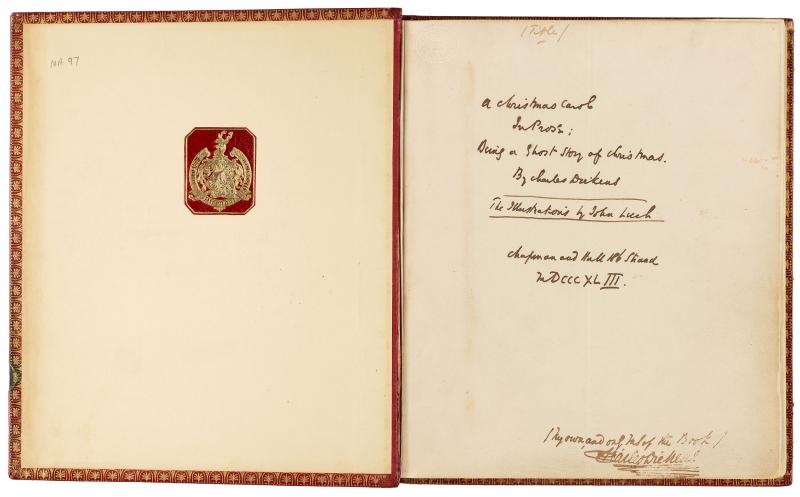
High reserve.
Includes extensive revisions.
On the title page: "A Christmas Carol / In Prose; / Being a Ghost Story of Christmas. / By Charles Dickens / The Illustrations by John Leech / Chapman and Hall No. 6 Strand / MDCCCXLIII. / My own, and only, MS of the Book"; signed by Charles Dickens.
Preface dated "December 1843" and signed "CD."
Signed on the back flyleaf by Francis Hopkinson Smith (dated Nov. 20, 1914) with a note from Belle Greene.
A double-barelled detective story : written mainly in Saranac Lake, NY : autograph manuscript signed "Mark Twain," 1901.
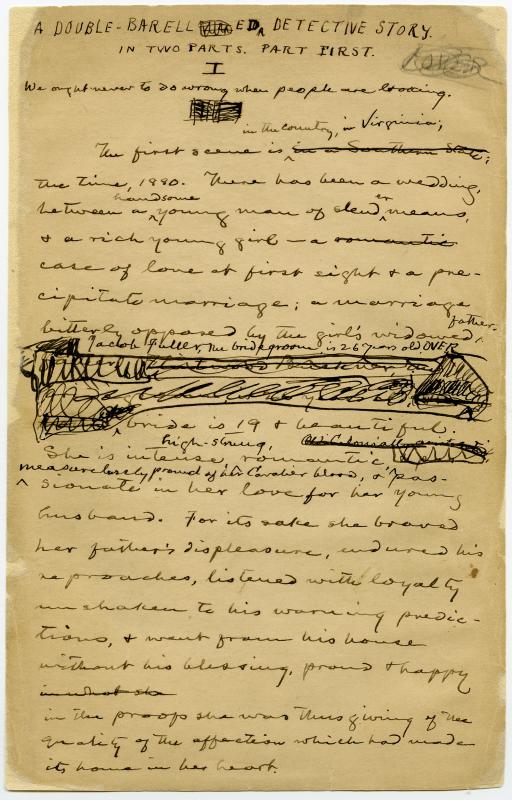
Written on the rectos of 125 folios, about 20 of which are also written on the verso. Part First foliated 1-35; with 1 additional folio between 20 and 21 labeled 20A. Part Second foliated 1-87; with 1 additional folio between 39 and 40 labeled 39 1/2, and 1 additional folio between 84 and 85 labeled 84 1/2.
Signed "Mark Twain" at end of manuscript.
Complete text of "A Double-barelled Detective Story." With notes and emendations to the text throughout, and with additional notes to Harper's concerning spacing and the division of the story into potentially three magazine issues.
Address of the Scots distillers : to the Right Hon. William Pitt : autograph manuscript, [1789 Feb.?].

Signed "John Barleycorn."
"Petition of the Scotch Distillers to Mr. Pitt" and "Address of the Scots Distillers" written on the verso of p. 3. The second note may be in Burns' hand; the first is in an unknown hand.
J. De Lancey Ferguson notes that the address was published in the Edinburgh evening courant on Feb. 9, 1789 and points out a reference Burns makes to a "piece of ... prose" he is mailing her that treads on "dangerous ground" (in a letter to Mrs. Dunlop dated Feb. 5, 1789).
With corrections; published versions of the address differ slightly from this draft.
An Ideal Husband : London : typescript of Act III, 1894.
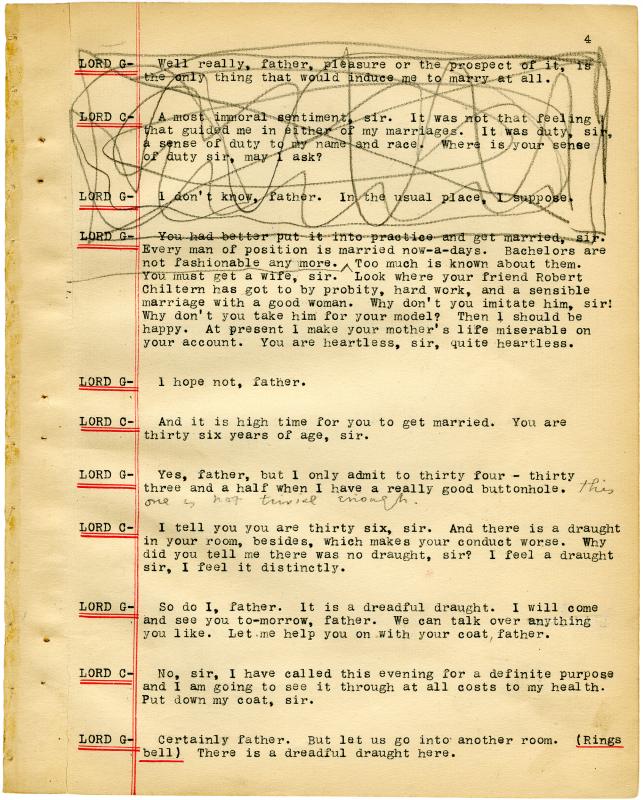
Stamped "Mrs. Marshall's Type Writing Office, 126, Strand, 24 Jan. 94" on the cover page.
Ruled throughout in red ink.
High reserve.
Being a typescript with extensive autograph revisions and additions throughout; revisions and additions, in ink and pencil, are made on the typescript (24 pages) and on the versos of 14 pages.
An essay on man : autograph manuscript of the first draft of the poem, undated [1730-1731].
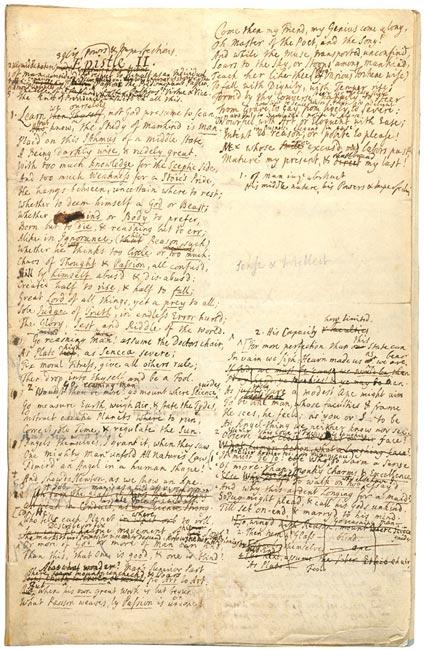
Dating: Previously cataloged as "finished in 1733," however Maynard Mack notes that the Morgan manuscript predates the Harvard manuscript, which was made in 1730-1731. A letter dated 2 August 1731 from Bolingbroke to Swift notes that three epistles have been finished and that Pope is working on the fourth.
Each epistle with wrappers of blue blotting paper. The front wrapper for Epistle III is labeled "Epist. 3d / N 1 & 2 / Learn Dulnes Learn! &c.;" the front wrapper for Epistle IV is labeled "Epis 1st of Man [in the Abstract] with respect to the Universal System." Additionally, Epistle I is preceded by an otherwise blank page with a note in Pope's hand reading: "Eipst. I of Man [in ye abstract] with respect to the universal System;" Epistle II by a page labeled "No. 2 / Learn we ourselves &c.;" Epistle III by a page labeled "1 / Learn Dulnes learn! &c.;" Epistle IV by a page labeled "No 1 / Popes Hymn to God &c & Epistle 4th."
Epistles I-III were in the possession of the Chauncey heirs in the 1860s when Rev. Whitwell Elwin consulted them for his Works of Pope.
High reserve.
Written on sheets of paper ranging from 18-31 cm. See Mack for a full bibliographical description.
An early draft of the poem, consisting of Epistle I (11 p.), Epistle II (6 p.), Epistle III (15 p.), Epistle IV (8 p.), with extensive revisions and corrections by the author throughout.
Astronomical observations by Galileo Galiei, 1611 January 14-25 : autograph manuscript.
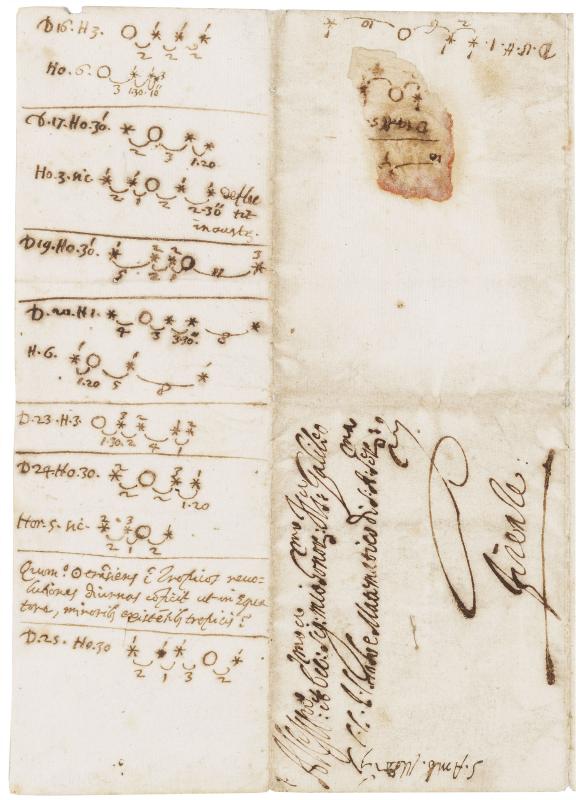
Watermark: Rampant lion in shield with initials "V4B" above and "ST" below; presumably German or Dutch paper per Paul Needham, 2010. Watermark, beta radiograph. Shield, rampant lion, V4B, ST 102153wm_MA_1064_1_WM_beta.jpg
High reserve.
Housed in a box with letters of Brahe, Newton and Robert Hooke.
Written on the wrapper of a letter addressed to Galileo.
Being astronomical observations recording data on the satellites of Jupiter.
Autograph journal : [California], 1938 Feb. - 1941 Jan. 30.
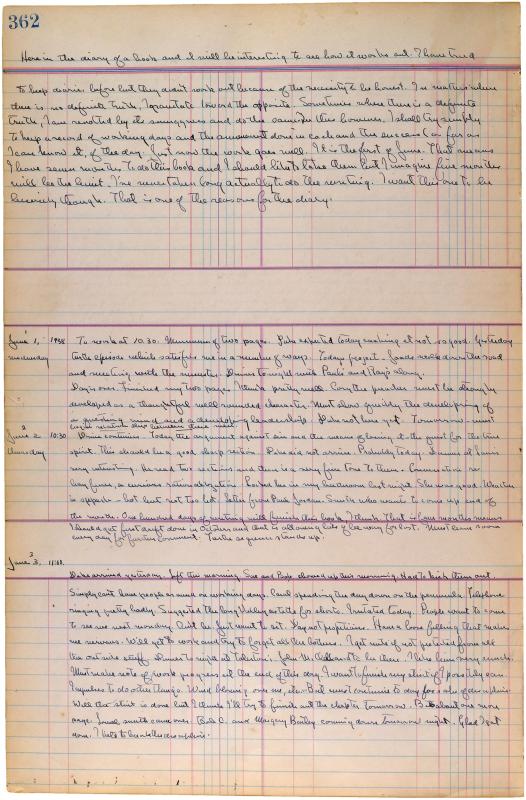
High reserve.
The "introduction" to the journal is a 22-line paragraph on page 361 and is undated except to say it is February; he refers to the fact the M[ice] & M[en] is running and successful which would place this entry in February 1938. The journal of the writing of The Grapes of Wrath begins formally on page 362 and is dated June 1, 1938 / Wednesday."
The proper sequence of the manuscript in the ledger runs from page 361 (February 1938) to the end at page 372 (August 4, 1938), then page 336 (August 8, 1938) through page 349 (October 26, 1938) and the completion of the first draft of The Grapes of Wrath; lastly page 300 (October 16, 1939) through page 309 (January 30, 1941), plus a list of characters on page 352.
Personal diary and journal of his writing of the The Grapes of Wrath from June 1, 1938 through October 26, 1938; journal entries from October 16, 1939 through to January 30, 1941 discuss his year away from writing with an infection in his leg, preparing for his research trip on the tidal pools in the Sea of Cortez, referring to a film in Mexico, his work on "[God in the] Pipes" and the constant battles with self-doubt and the discipline needed to continue writing.
Autograph letter signed : 50 Charlotte Street, Portland Place, London, to Leigh Hunt, undated [1847].
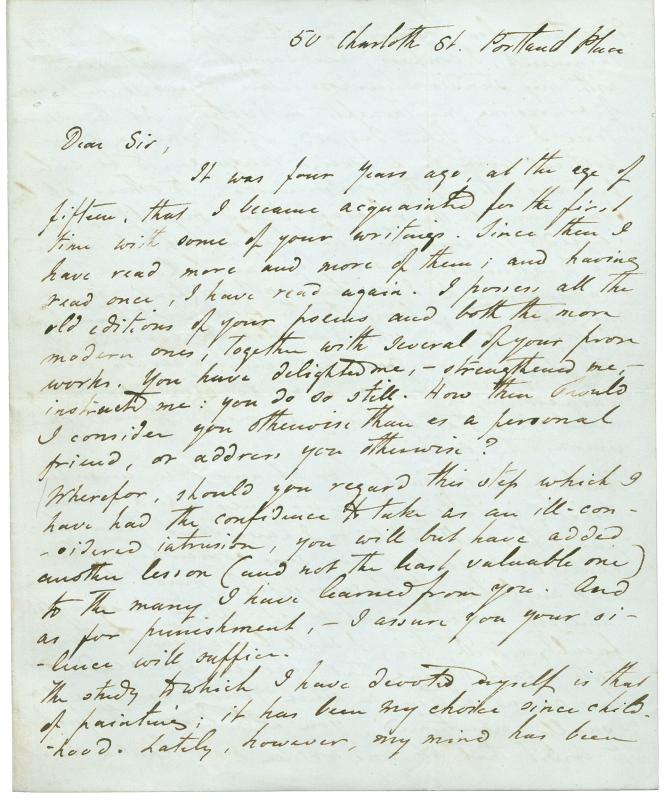
Letter is signed "Gabriel C. Rossetti," a form of his name which he stopped using shortly afterwards.
Rossetti writes to introduce himself, his poetry and translations to Hunt. The first part of the letter concerns Hunt's influence upon Rossetti and Rossetti's response to Hunt's writing -- he tells him he has "read more and more; and having read once; I have read again." He tells Hunt that his work has "delighted me, strengthened me, instructed me: you do so still." The letter also concerns Rossetti's ambitions as a painter and writer: "The study to which I have devoted myself is that of painting; it has been my choice since childhood. Lately, however, my mind has been directed also toward another object whose attainment, I confess, has sometimes interfered with my steadier purpose; this object is the power of expressing my thoughts in poetry." Rossetti submits his Italian translations to Hunt for his opinion, and reports his ambitions to translate the lyrical poems of Dante into English. Rossetti considers Hunt "the first of Italian translators" and "that a translator, to be successful, must have in himself something at least of the imaginative faculty."
Autograph letter signed : Aix en Provence, to his daughter Martha, 1787 Mar. 28.

To "my dear Patsy."
Docketed.
Watermark: M. Johannot & Fils around a central cockle shell.
Part of a large collection of letters from Thomas Jefferson to his daughter Martha. Letters in the collection are described in individual records; see main record for MA 1029 for details.
Discussing his trip to Aix en Provence, which was "undertaken with the hope that the mineral waters of this place might restore strength to [his] wrist"; warning her against indolence: "if at any moment ... you catch yourself in idleness, start from it as you would from the precipice of a gulph"; admonishing her to apply herself more diligently to reading her Livy, and noting that "we are always equal to what we undertake with resolution"; remarking that "it is a part of the American character to consider nothing as desperate; to surmount every difficulty by resolution and contrivance"; encouraging needlework as a remedy to idleness; telling her that he looks to her and to her sister "to render the evening of [his] life serene and contented."
Autograph letter signed : Antwerp, to Nicolas-Claude Fabri de Peiresc, 1630 Aug.
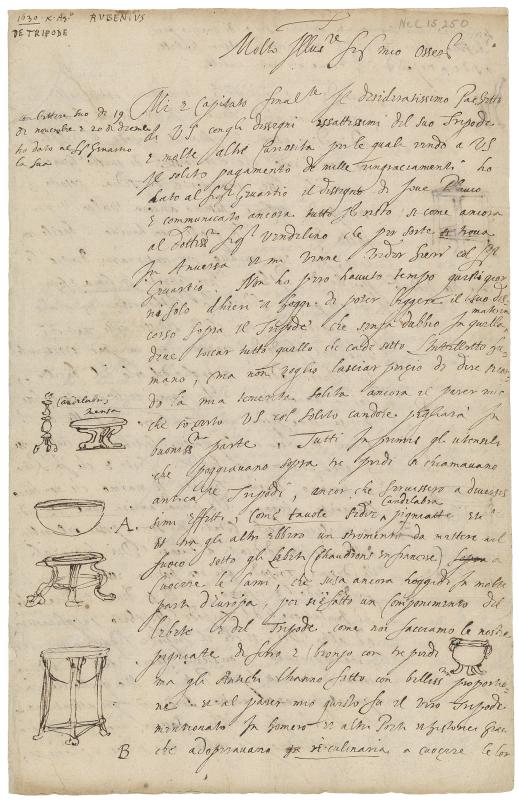
Watermark: Small horn.
Watermark: Countermark: Oval shield with P inside.
Mainly a treatise on the tripod, with marginal illustrations.
Autograph letter signed : Mount Vernon, to James Madison, 1792 May 20.
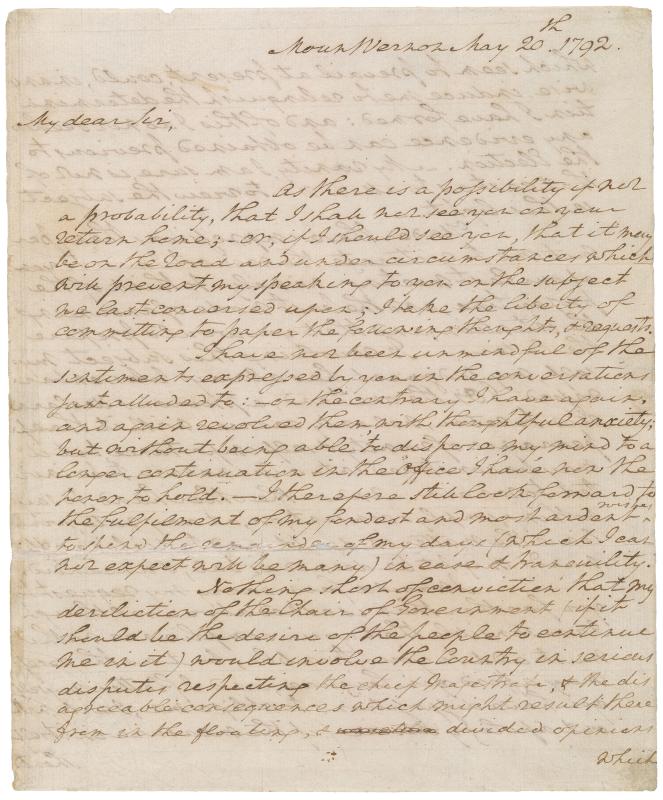
Disbound from a green leather gilt binding by Bradstreet's, lettered "Concerning Washington's Farewell Address;" binding housed in box with letter.
Docketed.
Requesting that he write a Farewell Address for him; asking what might be "the proper time and the best mode of announcing the intention;" suggesting certain sentiments he would like included.
Autograph letter signed : Rome, to Charles Townley, 1772 Aug. 3.
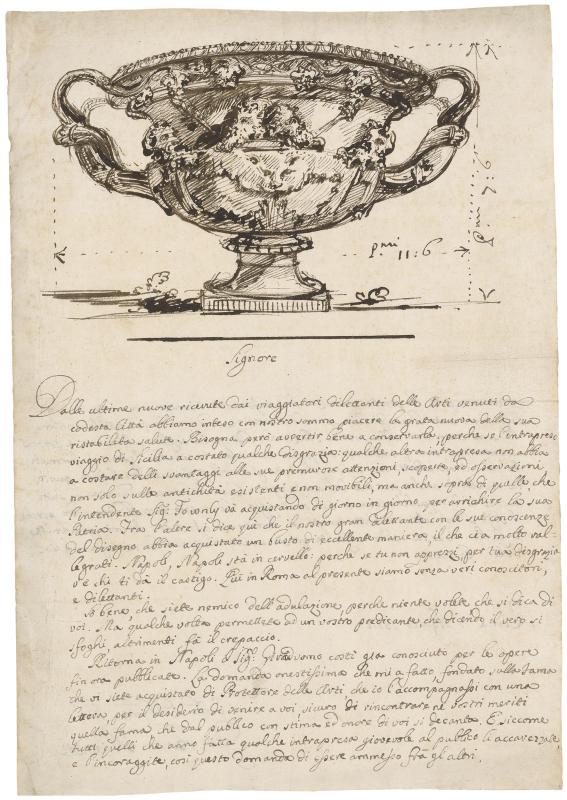
With an autograph draft of Townley's reply, dated Naples, 14 August 1772; cataloged individually as MA 4220.1; see related record for more information.
Watermark: Large shield with crown and scrollwork, fragment.
Praising him as a collector; with a pen and ink study by Piranesi of the Warwick Vase drawn as a heading for the letter.
Autograph letter signed : [Hatfield?], to Thomas Seymour, Baron Seymour of Sudeley, Lord Admiral of England, summer of 1548.
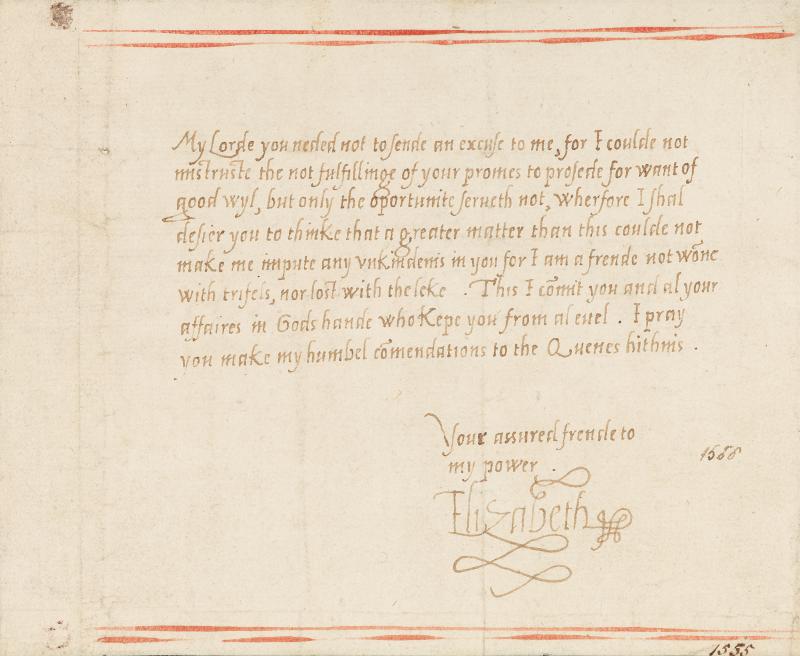
From the Thane-Paston Collection.
Signed as Princess.
Addressed on verso: "To my Lorde Admirall."
The years "1555" and "1566" have been written on the recto. These may have been later additions.
Autograph letter signed : place not specified, to "Dearest Bosie" [Lord Alfred Douglas], [1892 Nov.].
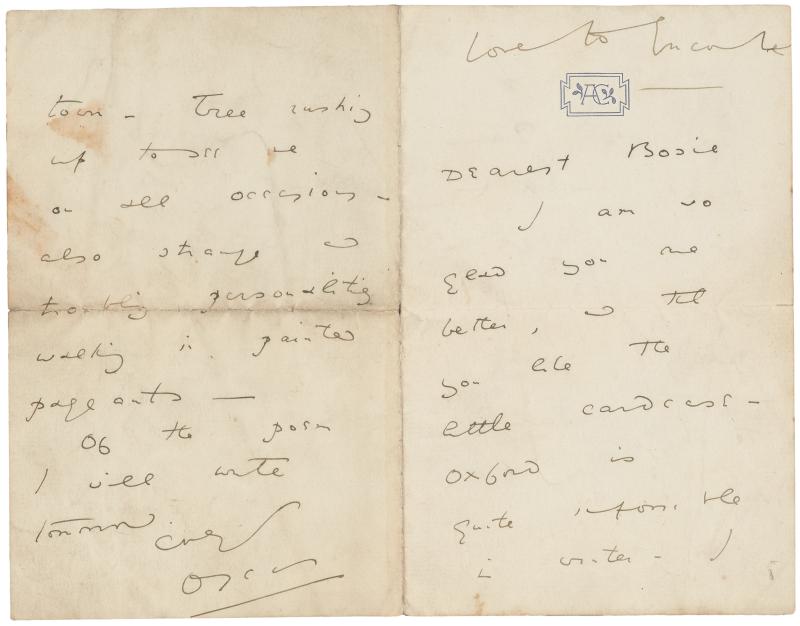
The earliest surviving letter from Wilde to Douglas.
The letter is undated; a probable date of writing of November 1892 is given for this letter in "The Complete Letters of Oscar Wilde," edited by Merlin Holland & Rupert Hart-Davis. London: Fourth Estate Ltd, 2000, p. 538-539.
Written on stationery printed with "AC" for the Albemarle Club.
Hoping he likes the card-case Wilde has sent as a gift; saying he is off to Paris and asking if Douglas is going to the Scilly Isles; saying "I should awfully like to go away with you somewhere where it is hot and coloured;" mentioning his meetings with [Herbert Beerbohm] Tree; at the top of the first page Wilde has written "Love to Enscombe" [Douglas's friend with whom he shared rooms at Oxford].
Autograph letters from Richard Doyle (51 items), Henry Edward Doyle (25 items), and Charles Altamont Doyle (3 items) : London, to their father, John Doyle, 1840-1845.
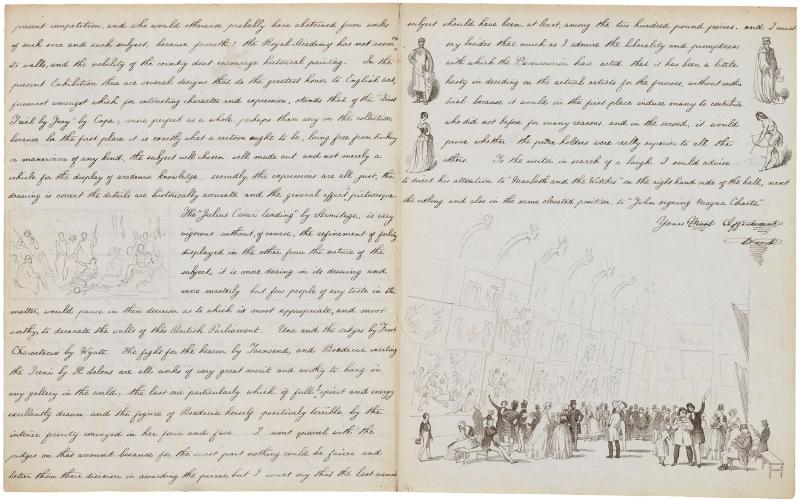
High reserve.
John Doyle was a portrait painter and political cartoonist; he published hundreds of sketches of political figures under the pseudonym "HB" over the course of his career. Richard, Henry, and Charles all pursued careers in the arts: Richard became an artist and illustrator, best known for designing the cover of Punch; Henry was a portrait painter and museum director for the National Gallery of Ireland; and Charles was a draftsman and illustrator (as well as the father of Sir Arthur Conan Doyle).
The letters in this collection were produced as part of a weekly assignment: starting in July 1842, the Doyle brothers were required to write a letter each week, describing their activities, reflecting critically on art, music, literature, and public events, and illustrating from memory the scenes and events they described. For more on the context and composition of the letters, see The Illustrated Letters of Richard Doyle to His Father, 1842-1843, pp. 7-11. Items in the collection have been described individually in separate catalog records; see related records for more information.
Autograph notes for political speeches : [Springfield, Ill.?], [ca. 1858 May 18-Aug. 21].
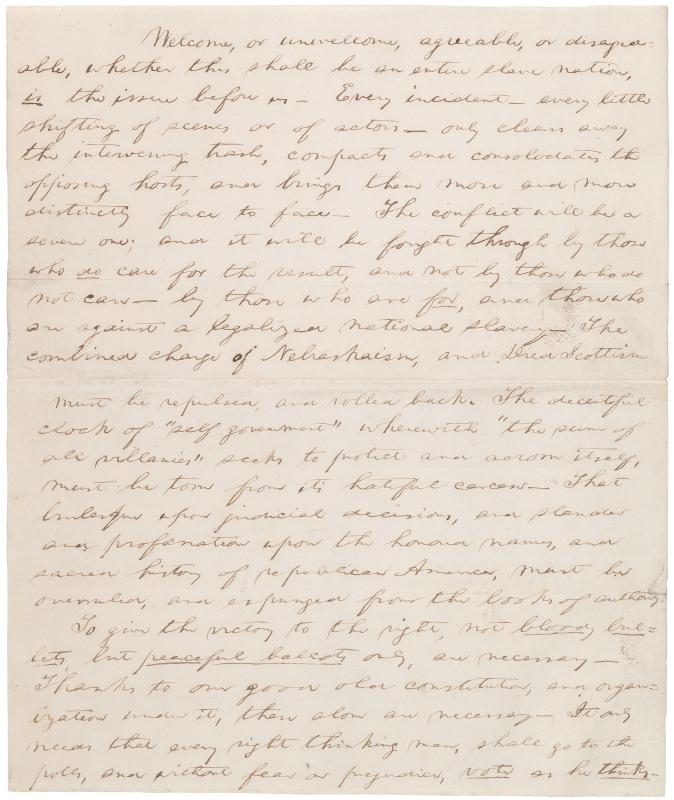
On Judge [Stephen] Douglas, his influence on public sentiment, and the conflict over slavery in the United States.
Collection of autograph letters signed : primarily London, primarily to Noel Moore, 1892 Apr. 11-1900 Mar. 3.
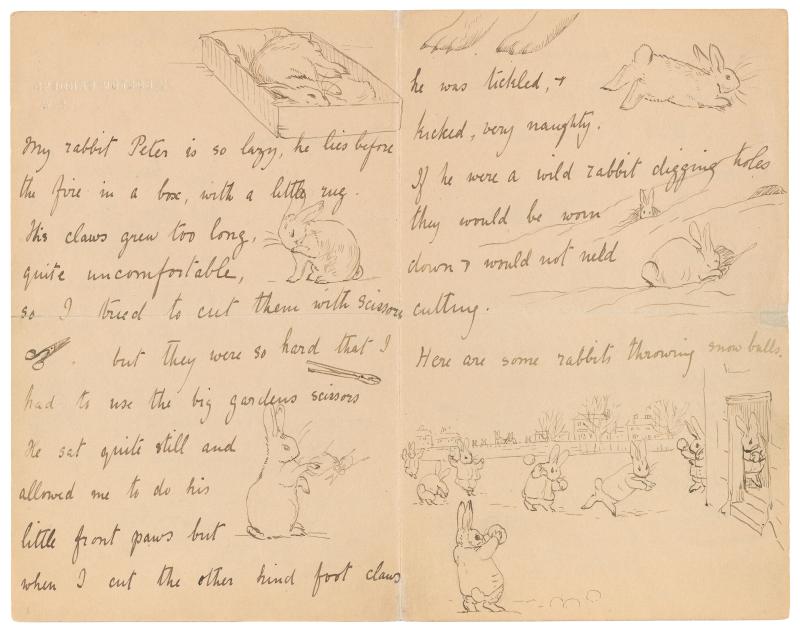
The original ideas for many of Beatrix Potter's stories can be found in the manuscript picture letters she wrote to children of friends and family members. Perhaps the most famous example is The Tale of Peter Rabbit, which began as an eight-page letter to Noel Moore, the five-year-old son of her former governess, Annie Moore. With Annie Moore's encouragement Potter borrowed back the letter, copied it out, and revised it for publication. At least six publishers rejected the book, but it was a huge success when the first trade edition finally appeared in 1902. The Tale of Squirrel Nutkin (1903), The Tale of Mr. Jeremy Fisher (1906), and other books in the Peter Rabbit series were based in whole or in part on her picture letters. In her opinion this was the secret of her success.
Her books retain the simple joy, subtle wit, and playful immediacy of impromptu private letters written for "real children" on subjects drawn from day-to-day experience with no commercial constraints and no thought of publication. Shown here are the twelve picture letters in the Morgan's collection. Eleven were addressed to Noel Moore, one to his younger sister Marjorie. Here one can see the earliest known picture letter along with later examples containing fanciful illustrations, comical vignettes, and narrative experiments that prefigure Peter Rabbit and other masterpieces of children's literature.
High reserve.
Noel Moore (1887-1969) was the eldest son of Annie Carter, Beatrix Potter's last governess. He later became an Anglo-Catholic priest working with the poor in London's East End.
Collection consists of 11 letters to Noel Moore, and 1 letter to his younger sister Marjorie. Letters to Noel describe Potter's travels and give anecdotes about her rabbit Peter. One includes a very short story about a dog named Stumpy, and the letters are extensively illustrated with pen drawings of animals and scenes illustrating Potter's anecdotes. The letter to Marjorie references Potter's attempts to publish The Tale of Peter Rabbit and describes an outing to the British Museum. Letters have been described individually in 12 catalog records (MA 2009.1-12); see related records for more information.
Collection of poems : autograph manuscript signed : [Haworth], 1838 Jan. 24-1841 Aug. 19.
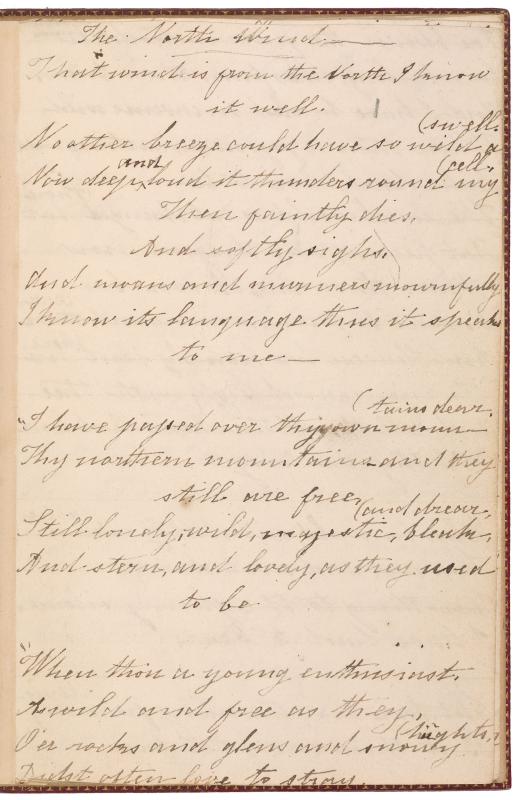
High reserve.
Contains 9 poems: The north wind (pp. 1-3, dated 1838 Jan. 26), The captive's dream (pp. 3-5, dated 1838 Jan. 24, printed in 1920 with the incorrect title "The captain's dream"), The parting (pp. 5-8, dated 1838 July 9), an untitled poem beginning "The lady of Alzerno's hall" (pp. 9-12; dated 1838 July 10, published in 1920 as "The parting," II), Verses to a child (pp. 12-15, dated 1838 Aug. 21), The bluebell (pp. 15-18, dated 1840 Aug. 22), An orphan's lament (pp. 18-21, dated 1841 Jan. 1), Lines written at Thorp Green (pp. 21-23, dated 1841 Aug. 19), and A fragment (pp. 23-26, dated 1840 Jan. 1; published in 1846 with title "Self-Congratulation"].
A fair copy of poems Brontë composed between 1838 and 1841. She copied the poems into a notebook that was cut into individual sheets rebound in leather many years after her death. She noted the dates of composition at the end of each transcription. Some of the poems bear the "signature" of characters in the Gondal chronicles, stories Brontë and her sister Emily created, as well as Brontë's own signature.
Contes de ma mère l'Oye : manuscript : [France], 1695.

High reserve.
Illustrated with seven gouache headpieces in color.
Prepared for presentation to "Mademoiselle" (Elisabeth Charlotte d'Orléans) with a dedication signed "P.P." [Pierre Perrault].
Text is possibly in the hand of Pierre Perrault.
Eugénie Grandet : autograph manuscript signed and typescript with manuscript revisions.
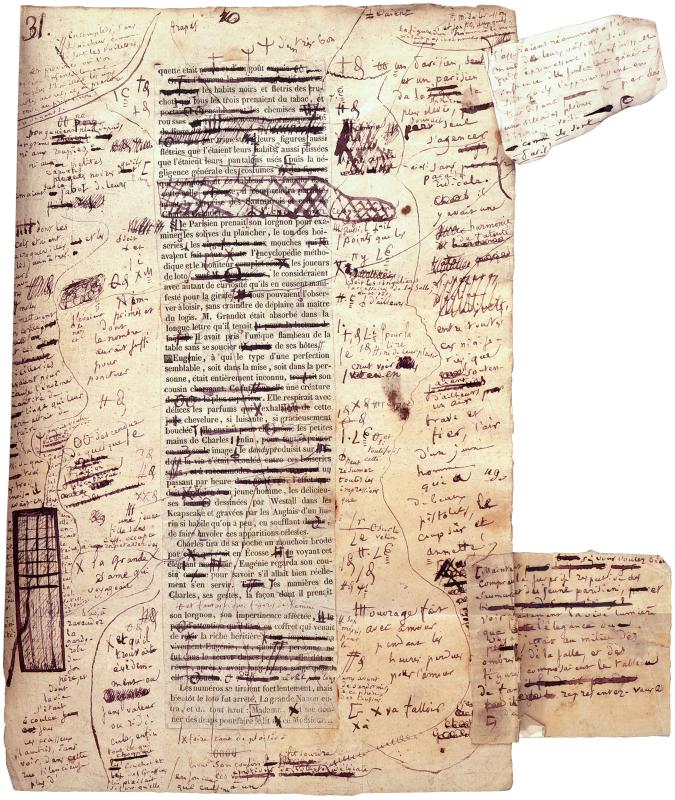
The typescript sections, which are heavily revised, appear to be proofs typeset for the novel's serialization in the magazine L'Europe Littéraire. In some cases, the manuscript and typeset pages duplicate each other: for instance, the beginning of the book appears both in manuscript and in typescript. However, the central section of the book is represented only in typescript, and the end of the book appears only in manuscript. Pages 34 and 35 (both typescript) also contain the same text, with different autograph revisions. These two pages appear to be proofs for two different issues of L'Europe Littéraire, though ultimately only the first section of the book was printed in the magazine, appearing in the September 19, 1833 issue, because of upheavals in the magazine's management.
Small pieces of paper containing additional edits have been attached to one extensively marked-up page at the center of the manuscript (identified by Balzac as page 31).
High reserve.
Includes a diagram on the verso of p. 1; a number of other pages contain extensive notes, drawings, and accounts on the verso.
Contains the author's signed presentation inscription to Madame de Hanska on the flyleaf: "offert par l'auteur à Madame de Hanska, en témoignage de son respectueux attachement 24 décembre 1833, Genève. H. de Balzac." Balzac married Madame de Hanska in 1850.
Consisting of the complete text of the novel Eugénie Grandet, partially in manuscript and partially in typescript. The first 8 pages are in manuscript, followed by 41 pages of typescript, and then by 106 pages of manuscript.
Grundgedanken und Methoden der Relativitätstheorie in ihrer Entwicklung dargestellt : autograph manuscript signed : [Berlin], [after 1920 Jan. 22].

Approximate date of writing identified by Janssen, p. 245; location of writing inferred from probable dating.
High reserve.
An article written for the British journal Nature (but not published therein) discussing, for the general reader, his theory of relativity. Written on the rectos of thirty-five leaves, with corrections throughout and signed "A. Einstein" at end.
Histoire de Babar, le petit éléphant : maquette with draft text and illustrations.
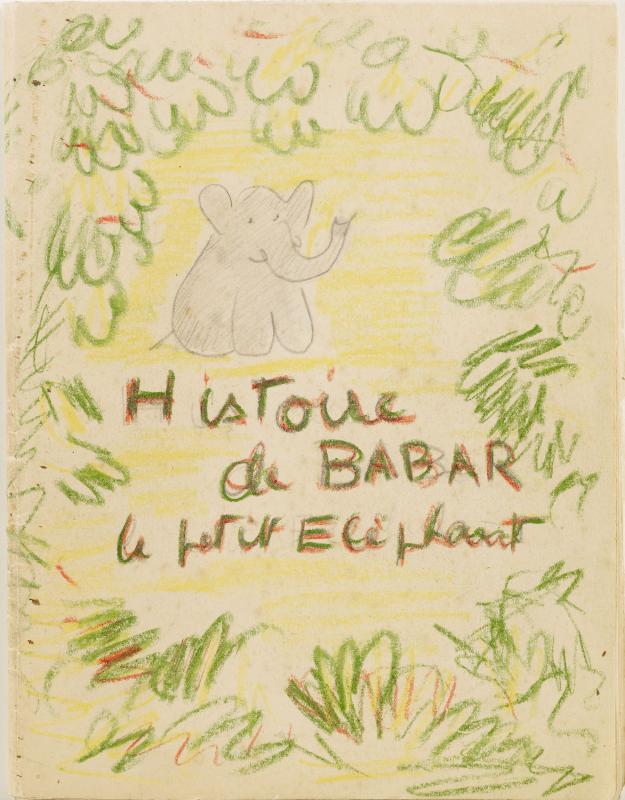
A handmade booklet with front and back cover, endpapers, text, and illustrations that served as de Brunhoff's prototype for "Histoire de Babar, le petit éléphant" (1931), the first book in the Babar series of children's books. After creating this maquette, de Brunhoff made significant changes in plot, structure, and text before creating the final drawings and manuscript for the published book.
On the title page of this maquette, Jean de Brunhoff listed himself and his wife, Cécile de Brunhoff, as co-authors because Cécile was responsible for the bedtime story that inspired the book. But she preferred not to be publicly acknowledged for her initial concept and Jean was thus ultimately credited as the sole author of the published book.
The maquette opens with the death of Babar's mother; however, de Brunhoff ultimately decided to add a three-page opening sequence showing the infant Babar in a hammock and a group of young elephants playing. While the maquette concludes with the marriage and coronation of Babar and Celeste, the published book ends with the newly married couple reflecting on their good fortune before taking off for their honeymoon in a yellow balloon.
The maquette is part of a larger collection of drafts and drawings for "Histoire de Babar" (MA 6304).
Maquette consists of 36 numbered pages plus additional front and back matter.
Dimensions of individual pages vary slightly.
Written on sheets of Johannot et Cie Annonay paper folded to approximate a book. The cover features a frontal view of Babar (in green, yellow, and red crayon); there is a rear view of Babar on the back.
Histoire naturelle des Indes : manuscript, ca. 1586.
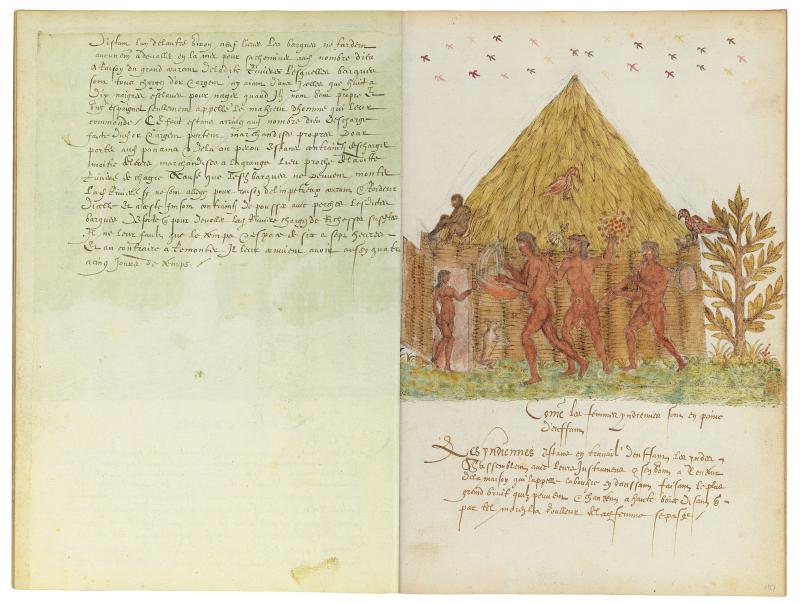
Contains 199 separate images of West Indian plants, animals and Indian life.
High reserve.
Most of the illustrations consist of a black chalk underdrawing and a combination of pen and brown ink with watercolor; on some images selected areas have also been glazed with a gum.
The combined work of at least two scribes and two artists. It may be a record of the early explorations of Sir Francis Drake (he is twice named in the text and the geographical references match his ports of call).
Though this work is often called the Drake manuscript, it bears on its title page (inserted when it was bound) the name Histoire naturelle des Indes.
Watermark: On title page, Wreath with words below.
Watermark: On page 9, Pot with one handle, letters "PDB" inside.
Watermark: On page 19, Sun inside crowned shield over cartouche with letters PVLEBED?, page 19.
Jane Austen [print].
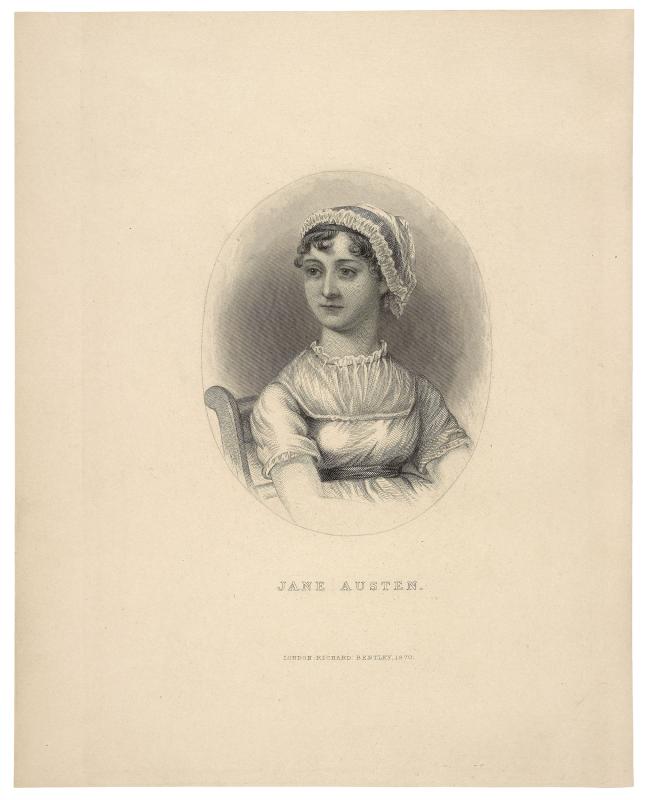
Engraving after a sketch by Cassandra Austen; evidently executed as a frontispiece portrait for James Edward Austen-Leigh's biography of Austen, A memoir of Jane Austen. London : Richard Bentley, 1870.
Housed with MA 2911.
Part of a collection that includes manuscripts, letters, and notes in Jane Austen's autograph. The collection also includes letters addressed to Austen by James Stanier Clarke and a steel engraving of Austen. Items in the collection are described in 12 individual records (MA 1034.1-12).
High reserve.
Seated three-quarter portrait of Austen in a ribboned cap with her arms resting in her lap.
Journal : autograph manuscript signed : Walden [Concord], 1845 July 5-1846 Mar. 27.
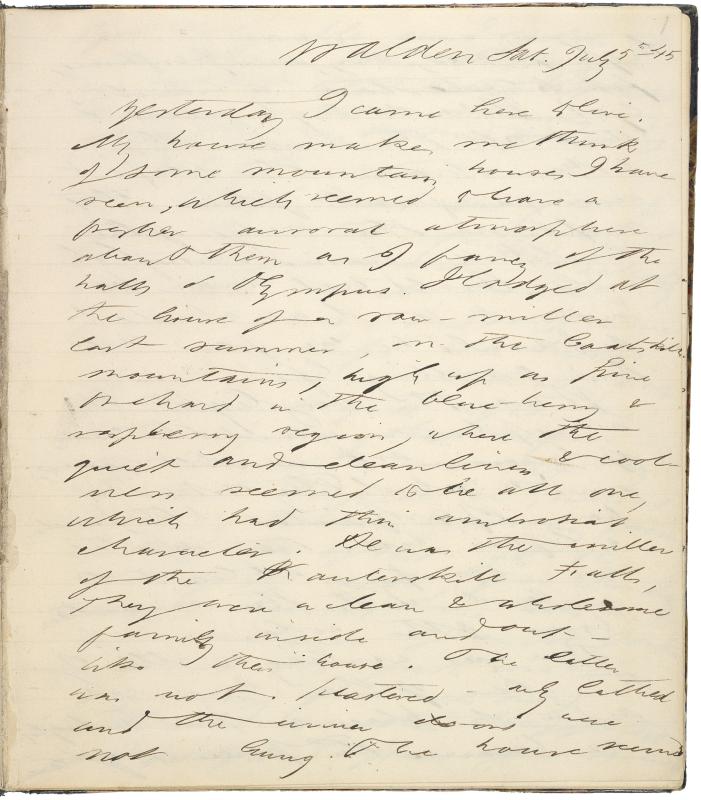
Irregularly paged in pencil "1-71" and "45-100"; in this numerical sequence pages 83-88, 91-128, and 131-142 are missing.
Written while Thoreau was living by Walden Pond. He used material from this journal for writing Walden.
Part of a collection of 39 journals written by Thoreau between 1837 and 1861. Journals are described in 39 individual records.
High reserve.
Journal de l'exil : autograph manuscript.

Lady Susan : autograph manuscript, fair copy.
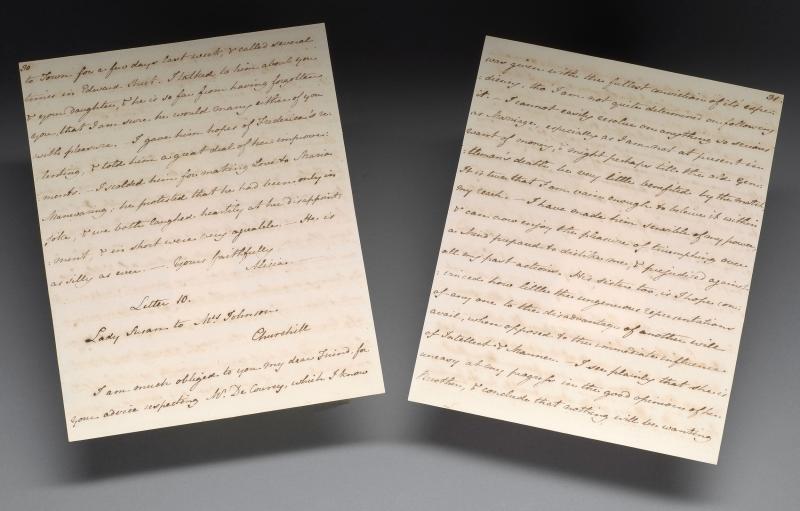
The manuscript of Austen's Lady Susan is the only surviving complete draft of any of her novels. All of the manuscripts of Austen's novels were probably destroyed after serving as printer's copy, and neither she nor her family retained any of the earlier, rough drafts of the four novels published during her lifetime or the two novels published posthumously. The manuscript of Lady Susan is a fair copy in Austen's hand, almost free of corrections or revisions. There is no conclusive evidence for the date of composition, but Austen probably wrote Lady Susan in 1794-95. Two of the 158 pages of this manuscript are watermarked 1805, suggesting that she transcribed her earlier draft (which does not survive) between 1805 and 1809, perhaps for possible publication. Austen appears to have left the novel untitled. This manuscript of Austen's epistolary novel (a novel in the form of a series of letters) was first published in 1871 by her nephew James Edward Austen-Leigh in his Memoir of Jane Austen.
High reserve.
Left complete but unpublished and without title at the author's death.
Written on 79 leaves, 2 of them bearing the date 1805 in the watermark.
Watermarks: Fragment of lion(?) with sword inside crowned triple circle, pages 3, 7, 9-10, 11, 19-20, 21, 56-57.
Watermarks: SHARP, pages 55, 97-98, 151-152.
Watermark: Lion(?) with sword inside crowned triple circle, page 70-71.
Watermarks: 1805, pages 85, 107-108.
Being a fair copy in the author's hand, written on the rectos and versos of 79 leaves; with a dedication, most likely in Austen's hand, "For / Lady Knatchbull."
Lettres de deux amans, habitants d'une petite ville aux pieds des Alpes : autograph manuscript signed, undated [1759].
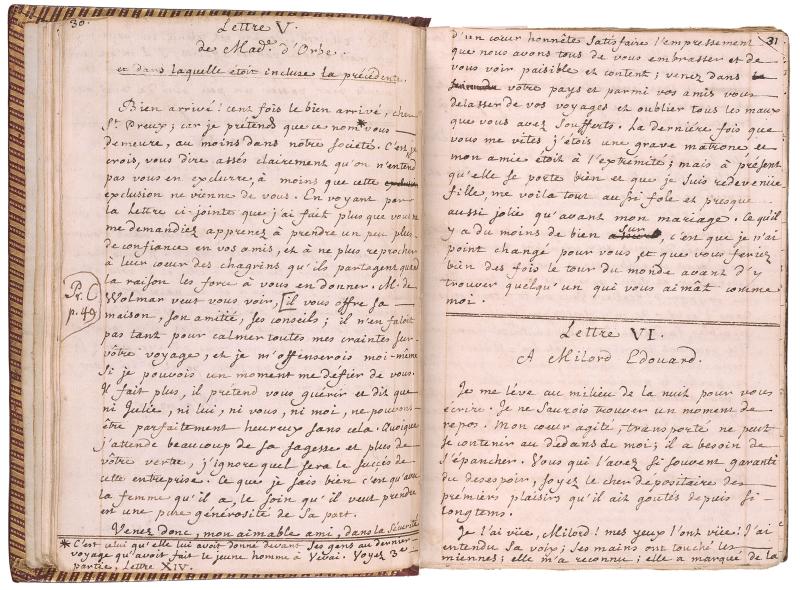
An autograph fair copy made by Rousseau for the printer Marc-Michel Rey in Amsterdam, with some minor corrections, revisions and additions throughout. Bound in two volumes: parts 1-3 (paginated by Rousseau 1-3 (preface); 1-196; [1] (title page for part 2, signed); 1-144; 1-139) in vol. 1; and parts 4-6 (paginated by Rousseau 1-191; 1-161; [1-3] (preface); 1-159) in vol. 2. Each part is titled "Lettres de deux amans, habitants d'une petite ville aux pieds des Alpes." A later hand has added "La Nouvelle Héloïse" to p. 1 of vol. 1.
Date of writing based on a letter from Rousseau to Rey, dated Montmorenci, 14 March 1759, in which Rousseau discusses his intention to copy and send Julie to Rey in monthly installments, hoping to have the project completed by November. (He remarks: "Je veux tenir l'engagement que j'ai pris avec vous au sujet de la Julie. J'ai examiné l'état du manuscrit, et ne le trouvant pas assés net pour vous être envoyé dans cet état, je prends le parti de le recopier en entier, et je vous enverrai la copie partie par partie à mesure qu'elle sera faite. Je compte que la prémiére partie partira le dernier du mois prochain, et je tâcherai de vous envoyer les autres de mois en mois en sorte que vous ayez receu le tout dans le courant de novembre au plus tard.")--Cf. R. A. Leigh, ed. Correspondance complète de Jean Jacques Rousseau: 1759. (Geneva: Institut et Musée Voltaire, 1965-1998) vol. 6, p. 43-46, no. 788.
Formerly housed in a contemporary decorative pull-off box of red leather and paper, with green leather panel on spine and heavily gilt-tooled spine, which was made to hold both volumes. The volumes are no longer housed in the old box; but the box has been retained.
Marc-Michel Rey printed the original edition (the only one acceptable to Rousseau) from this manuscript.--Cf. Books and Manuscripts from the Heineman Collection (New York: Pierpont Morgan Library, 1963), p. 45-46.
The manuscript has been digitized.
With a note on the front pastedown of the first volume concerning the manuscript, initialed by Henry Seymour and dated March, 1837.
Manfred : autograph manuscript of the play, [1816 July-1817 Mar.].
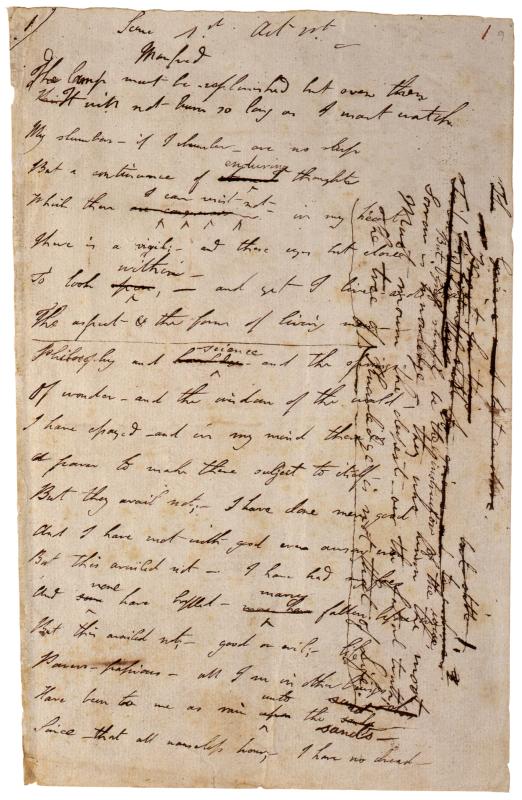
Draft is unsigned.
Includes a leaf at the end of the manuscript with a 30-line version of "Ashtaroth's Song" (first line: "The Raven sits") from Act III, Scene i of Manfred.
Housed with Byron's autograph manuscript of Il Morgante Maggiore, which is described in a separate record (MA 59.1).
High reserve.
Maximilien Robespierre on the day of his execution [drawing].
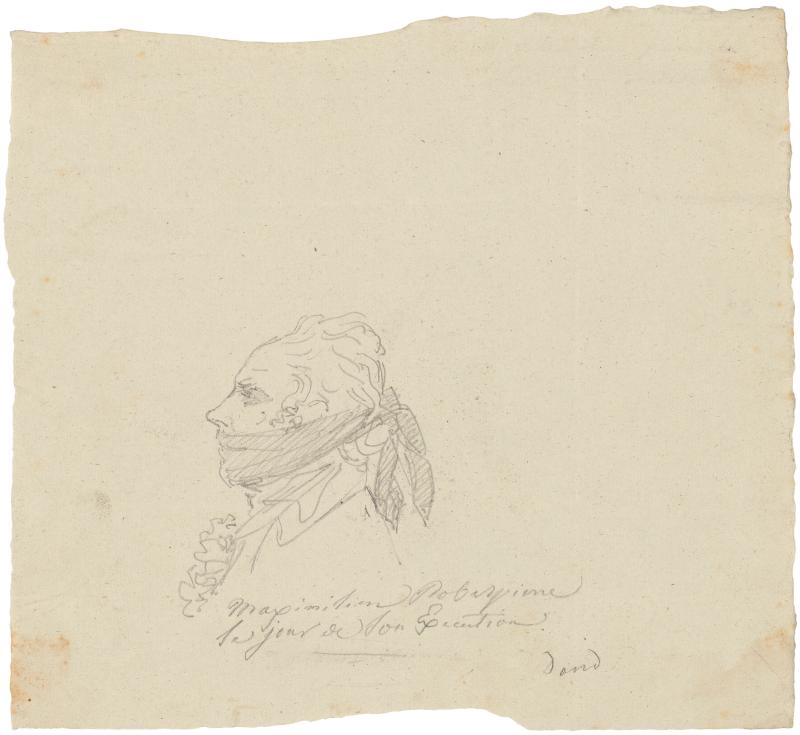
Attributed to Jacques Louis David, but signature at lower right corner may not be that of the artist.
Part of a collection of documents and graphic materials related to Maximilien Robespierre. Items in this collection have been described individually in separate catalog records; see collection-level record for more information.
Drawing shows head and shoulders of Robespierre in profile, with a bandage covering his wounded jaw.
Of taste : an epistle to The Earl of Burlington : autograph manuscript.
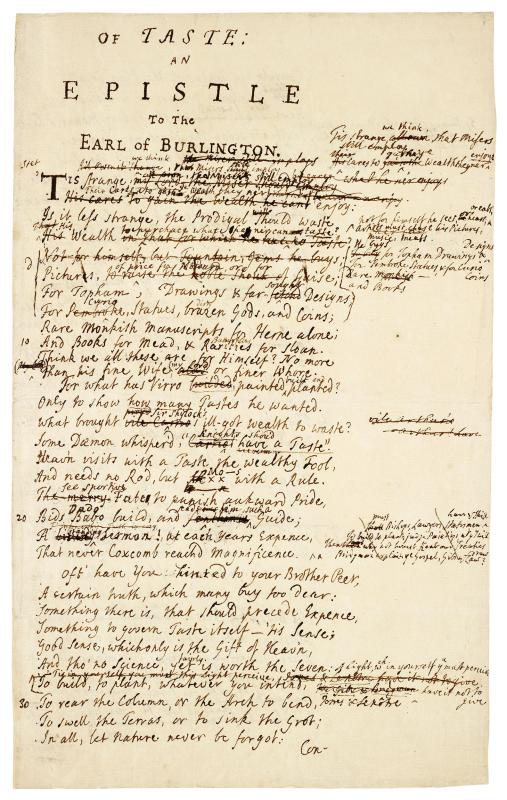
Formerly bound in red morocco gilt by Riviere & Son for S.M. Samuel in 1803; portions of the upper and lower covers have been retained and are housed with the manuscript.
Housed with an autograph manuscript of Pope's "Epistle to Dr. Arbuthnot" (MA 352.1) and two facsimile pages of a fragment of this poem that are housed at The Huntington Library (HM 6006).
Housed with the printed version of this poem, London, 1731.
Housed with a hand-colored mezzotint portrait of Pope.
Watermark: Circle with crown over letters "GR" and leaves inside.
Written on the recto and versos of one leaf, with extensive revisions; being part of an early draft of the poem, which in this form constitutes less than a third of the final printed version.
Our mutual friend : autograph manuscript, 1865 Sept. 2.
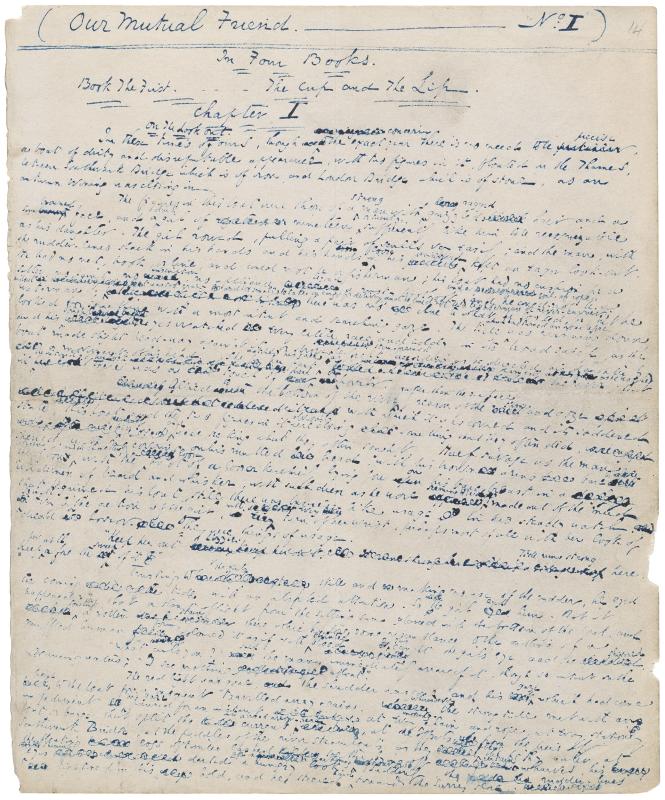
High reserve.
The manuscript as sent to the printer with innumerable cancellations and corrections. Manuscript is dated September 2nd, 1865 on final page. Text of the novel is preceded by: a list (10 p.) of chapter headings with parallel columns of Dickens' notes for the same, and by a blank page with Dickens' signature, dated Thursday Fourth January, 1866. The upper part of this blank leaf, evidently containing the name of a friend to whom the manuscript was given, has been cut away.
Paradise lost : Book I : manuscript, ca. 1665.

This is the only surviving fragment of the manuscript used to print Paradise Lost, Milton's epic poem of the Edenic fall. It is difficult to overstate the influence of Milton's poem on subsequent writers and artists, particularly in his vivid portrayal of Satan, whose seductive logic and rhetorical virtuosity have captivated readers for generations. Driven to achieve "things unattempted yet in prose or rhyme," Milton adopted innovative thematic and formal approaches for Paradise Lost, sourcing his characters from the Bible (rather than British history) and composing his lines in blank verse instead of heroic couplets, which were more fashionable at the time.
Milton wrote the ten books of Paradise Lost between 1658 and 1663. He had first planned the work as early as 1640, intending to write a tragedy titled Adam Unparadised. By 1652 he had become completely blind, probably due to glaucoma. The final words on the manuscript's first page of text--"what in me is darke / [Illumine]"--refer not only to the speaker's moral and intellectual uncertainties but also allude to the physical darkness that engulfed the poet. Blindness forced Milton to compose orally, rendering him entirely reliant upon amanuenses (casual copyists among his friends and family circle) to whom he gave dictation. He composed the poem mostly at night or in the early morning, committing his composition to memory until someone was available to write down his words. He revised as his text was read back to him, so that a day's work amounted to twenty lines of verse. This fair copy of the poem's first book was transcribed by a scribe or literary secretary and bears further annotations by the printer (Samuel Simmons) and the compositors working for him.
As sent to the printer, Samuel Simmons, having in the margins the printer's marks for the division into sheets.
Bearing the imprimatur of the chaplain to the Archbishop of Canterbury, reading: "Imprimatur / Tho. Tomkyns {Rmo in / Christo Patri ac Domino / Dno Gilberto divina Providentia / Archi-Episcopo Cantuariensi a / Sacris domesticis. / Richard Royston / Int.-- / p. Geo: Tokefeilde Cl :"
Some corrections in the hand of Milton's nephew Edward Phillips.
Watermark: on conjoined pages 2-3, along fold. Pot with one handle and with letters "F" over "DC" inside, base present and crescent at top.
Watermark: on conjoined pages 6-7, along fold. Pot with one handle and with letters "F over DC" inside, base present and crescent at top.
The only surviving manuscript of Paradise Lost is this 33-page fair copy, written in secretary script by a professional scribe, who probably transcribed patchwork pages of text Milton had dictated to several different amanuenses. This fair copy was corrected by at least five different hands under Milton's personal direction and became the printer's copy, used to set the type for the first edition of the book.
Plan of a novel, according to hints from various quarters : autograph manuscript, [ca. 1815].

High reserve.
Part of a collection that includes manuscripts, letters, and notes in Jane Austen's autograph. The collection also includes letters addressed to Austen by James Stanier Clarke and a steel engraving of Austen. Items in the collection are described in 12 individual records (MA 1034.1-12).
Watermark: Horn inside crowned shield, over 1813.
Preamble of the charter of The United Nations : calligraphic manuscript by Hermann Zapf : Frankfurt am Main, 1960.

Written in black, blue, and red.
Signed in gray by Hermann Zapf.
A calligraphic copy of an original document dated San Francisco, 26 June 1945.
Signed also by Zapf on verso.
Profits of my novels, over & above the £600 in the Navy Fives : autograph note, [ca. 1817 Mar.].
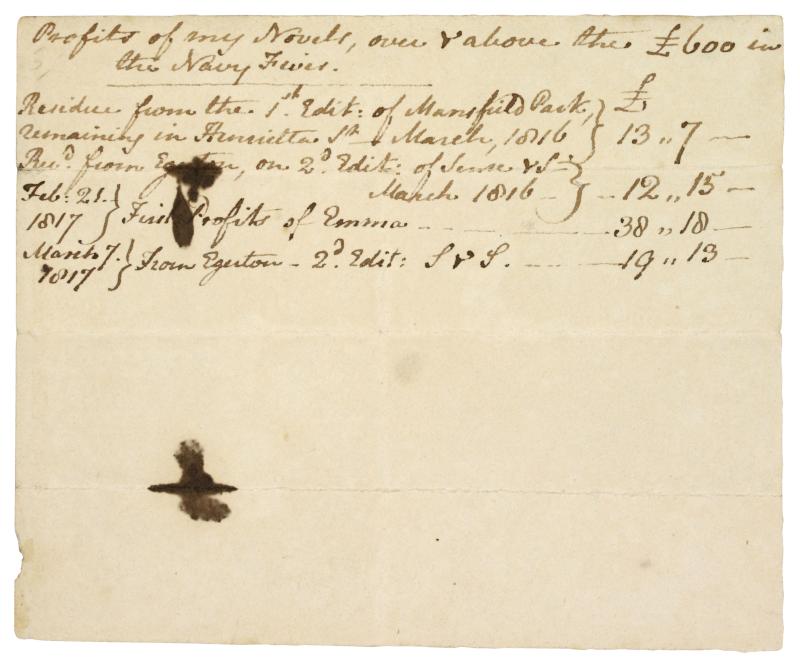
Part of a collection that includes manuscripts, letters, and notes in Jane Austen's autograph. The collection also includes letters addressed to Austen by James Stanier Clarke and a steel engraving of Austen. Items in the collection are described in 12 individual records (MA 1034.1-12).
High reserve.
Listing profits from Mansfield Park, Sense and Sensibility, and Emma.
Pudd'nhead Wilson : autograph manuscript : Florence, 1893 Mar.
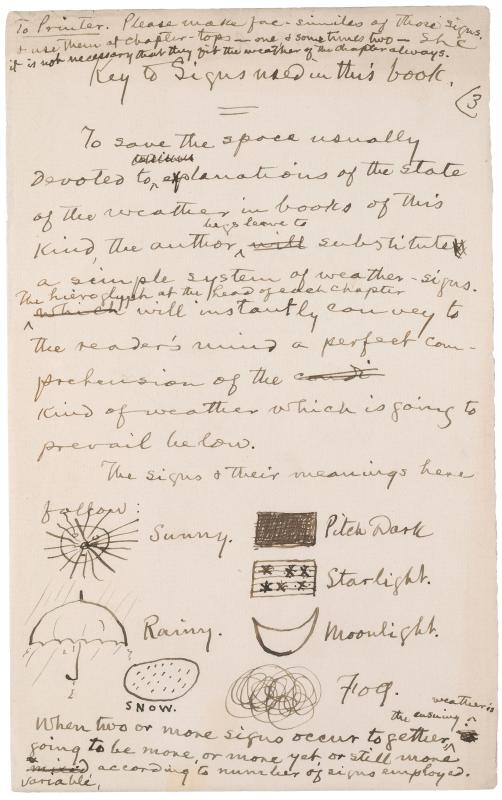
21 chapters (numbered 33 in the manuscript, chapter 33 being used in the published version instead of the original conclusion).
An autograph note at the conclusion of the text indicates that the manuscript was completed in Florence, Italy, in March of 1893.
Formerly bound with an autograph letter (MA 881.1) signed S.L. Clemens to J. Pierpont Morgan concerning the purchase of the manuscript, dated Stormfield, Redding, Conn. Sept. 15, 1909. See individual record for MA 881.1 for full description of the letter.
High reserve.
Manuscript is heavily revised, containing many corrections and emendations, and also with directions to the compositor. Includes unpublished portions, including an alternate ending.
The manuscript incorporates passages later included in the published work Those Extraordinary Twins.
Written on the rectos and some versos of 637 pages. Some pages are typewritten.
Note on pagination: The manuscript of Pudd'head Wilson was once bound in two volumes, accessioned as MA 881 and MA 882. The volumes were disbound in the 2000s and the manuscript is now in loose sheets housed in two drop-spine boxes. Twain's own continuous numbering (1-635, with some variations and unnumbered pages) appears at the top of most of the sheets.The Morgan has added folio numbers in pencil at the foot of the verso of each sheet (MA 881, f. 1-293, corresponding to Twain's pages 1-291; MA 882, f. 1-345, corresponding to Twain's pages 292-635).
Self-portrait [drawing].

Signed "EEC" and dated "29/11/26" on recto. "Self-portrait 1920's" in pencil on verso.
Part of a collection of 21 letters from E. E. Cummings to Mina Curtiss (MA 4292.1-21); 7 letters from Marion Morehouse to Mina Curtiss (MA 4293.1-7); 51 drawings and sketches (MA 4291.1-51); and 4 photographs (MA 4291.52-55). Items are cataloged individually in 83 records.
Head-and-shoulders portrait of Cummings wearing a tie and jacket, and with hair neatly combed back and gazing directly at the viewer.
Stones of Venice : autograph manuscript : [n.p.], [1851-1853].
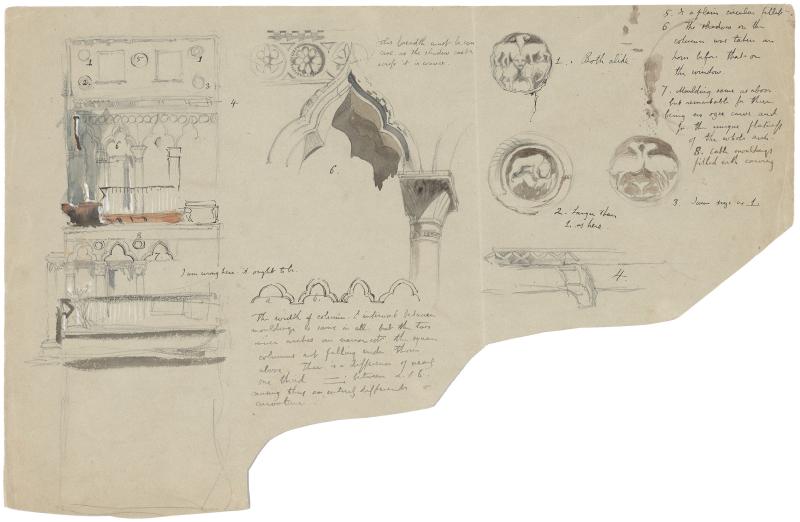
High reserve.
The Paris Review archives, 1952-2003.
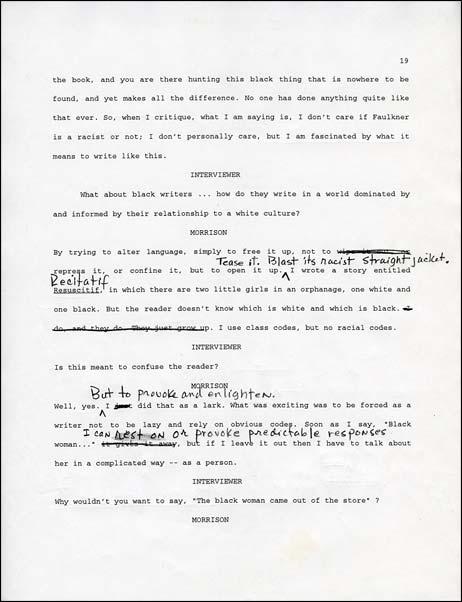
Correspondence, typescripts, and galley proofs of several hundred writers; editorial, production, and business correspondence; and other records of the international literary journal from just before its founding in 1953 through 2003. Includes editorial correspondence of Donald Hall, Robert Silvers, Maxine Groffsky, and George Plimpton; and of magazine staff, editors, and publishers, including Sadruddin Aga Khan, Tom Clark, Blair Fuller, Jonathan Galassi, X.J. Kennedy, James Linville, Peter Matthiessen, Mona Simpson, and Hallie Gay Walden. Many writers are represented, including W. H. Auden, James Baldwin, T. Coraghessan Boyle, Italo Calvino, John Cheever, Andrei Codrescu, Billy Collins, Ernest Hemingway, Fayette Hickox, Erica Jong, Jack Kerouac, Kenneth Koch, Maxine Kumin, Doris Lessing, Archibald MacLeish, Norman Mailer, James Merrill, Marianne Moore, Toni Morrison, Vladimir Nabokov, Joyce Carol Oates, Philip Roth, Mary Lee Settle, Anne Sexton, Terry Southern, John Steinbeck, William Styron, John Updike, Eudora Welty, and E. B. White. The collection also includes substantive correspondence with literary agencies, audio recordings of many of the in-depth interviews with prominent writers, photographs of staff and authors, and issues of the journal.
The Rose and the Ring : autograph manuscript : Rome, 1853.
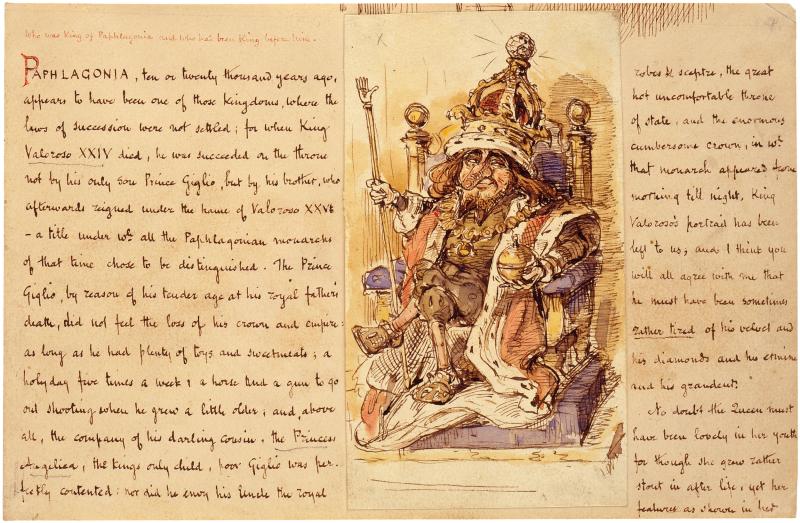
High reserve.
Written on the rectos of 90 pages with 50 pen and ink drawings, 29 watercolor drawings and 1 pencil sketch mounted on the manuscript pages.
The night of storms has passed : autograph manuscript signed : [Haworth], 1837 June 10.
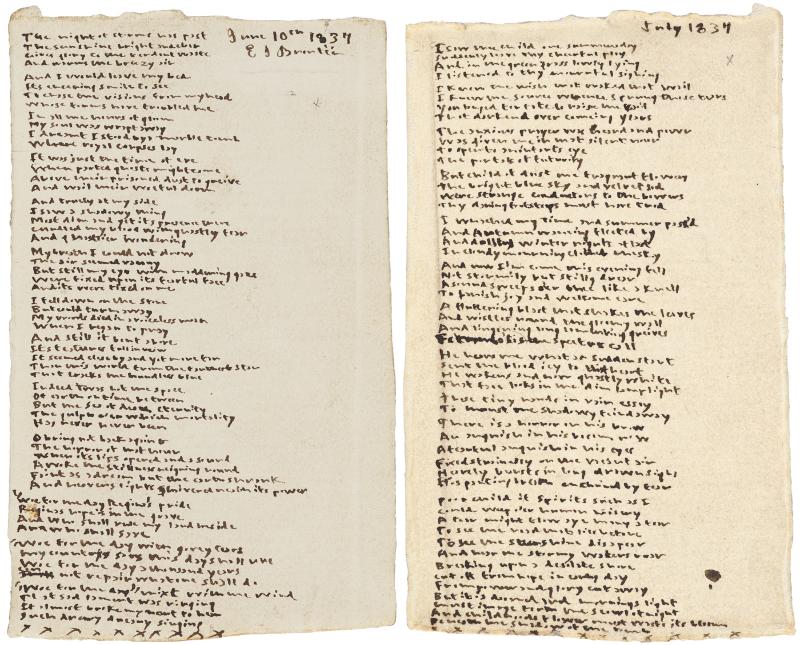
On the verso: "I saw thee child one summer's day," autograph manuscript unsigned, dated July 1834.
Both poems are written in a microscopic hand.
High reserve.
Ulysses : single leaf of typescript (on recto) and manuscript (on verso) : Paris, [1921].

The typed page is numbered 11.
The sheet once had three holes punched along left side, now mended.
The manuscript is an earlier draft of the passage printed on p. 631 of the 1922 edition.
Manuscript begins "Grand Lyric Hall..."; typescript begins "Was the quest conscious..."
Acquired with PML 41670, a copy of the first edition of Ulysses.
High reserve.
Untitled Drawing

Marked C4 on verso.
Original location in archives: Calder artist's files, 1964 Solomon R. Guggenheim Museum exhibition folder, 4.11
One of 35 sheets of drawings of mobiles and stabiles. Some have prices indicated, some have dimensions. Some are black-and-white and some are in color. In some cases there are also drawings on the reverse. Some have written notes.
John Ruskin
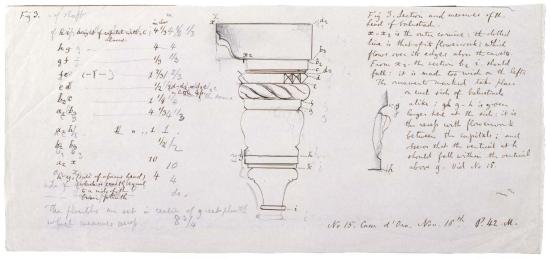
Manuscript leaf from The Stones of Venice, 1851-53
Purchased by Pierpont Morgan, 1907
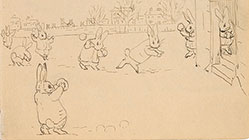
Compelled by personal financial difficulties, Dickens wrote A Christmas Carol in only six weeks, during a period of intense creativity in fall 1843. The original manuscript of A Christmas Carol reveals Dickens's method of composition, allowing us to see the author at work. The pace of writing and revision, apparently contiguous, is urgent, rapid, and boldly confident. Deleted text is struck out with a cursive and continuous looping movement of the pen and replaced with more active verbs--to achieve greater vividness or immediacy of effect--and fewer words for concision. This heavily revised sixty-six-page draft--the only manuscript of the story--was sent to the printer in order for the book to be published on 19 December, just in time for the Christmas market.
When the manuscript of A Christmas Carol was returned by the printer, Dickens sent it to a bookbinder (possibly Thomas Robert Eeles of Cursitor Street, London), who bound it in crimson morocco, a handsome, durable goatskin leather. The binding is elegantly decorated in gilt, and the name "Thomas Mitton Esqre" is stamped in gilt on the front cover. Dickens presented the bound manuscript to Mitton, his close friend and creditor, possibly as a Christmas gift, and most probably in gratitude for the generous loan of £270 in the preceding six months.